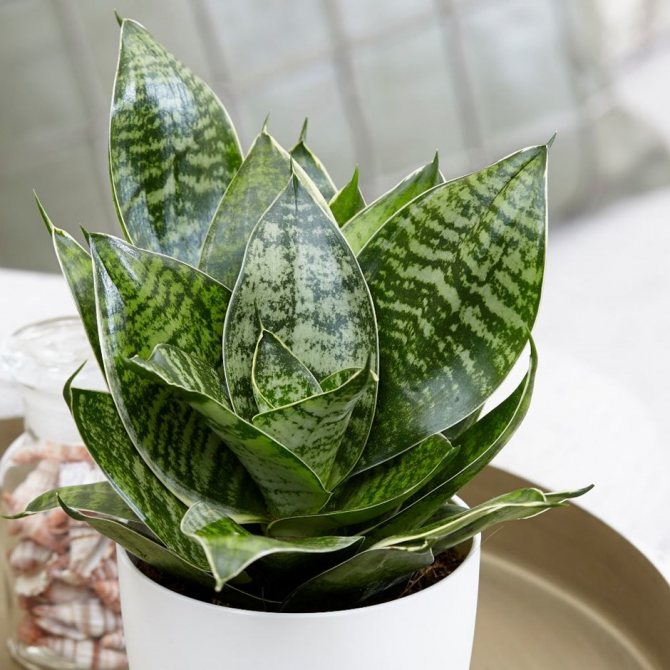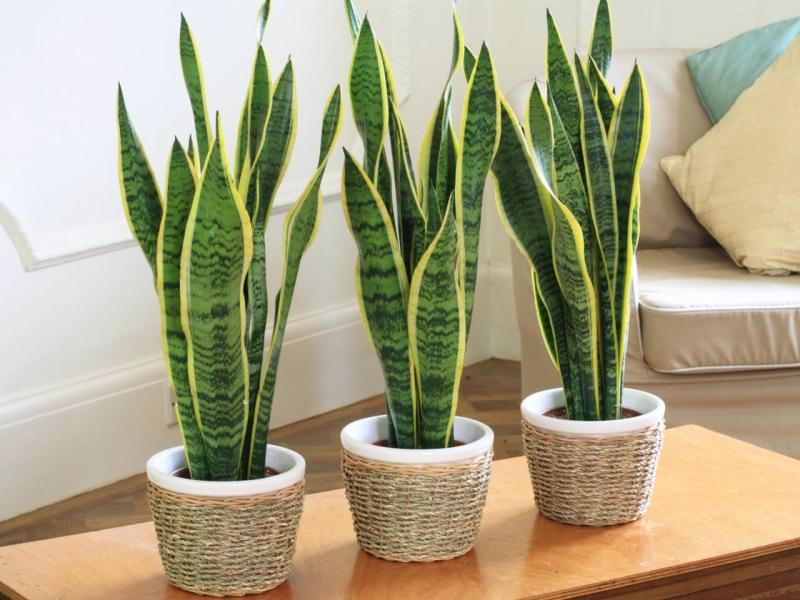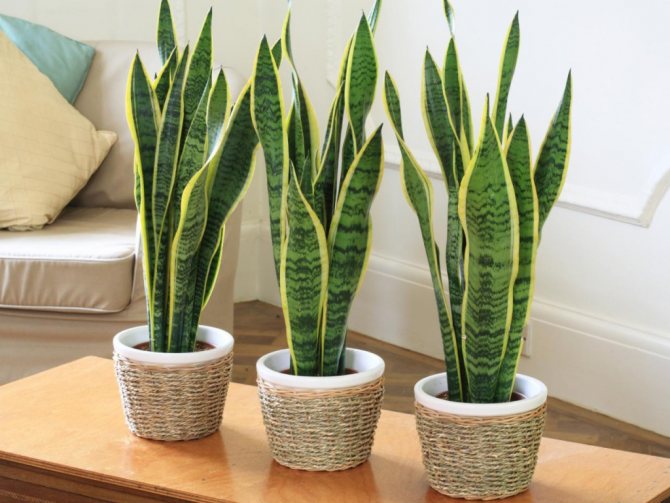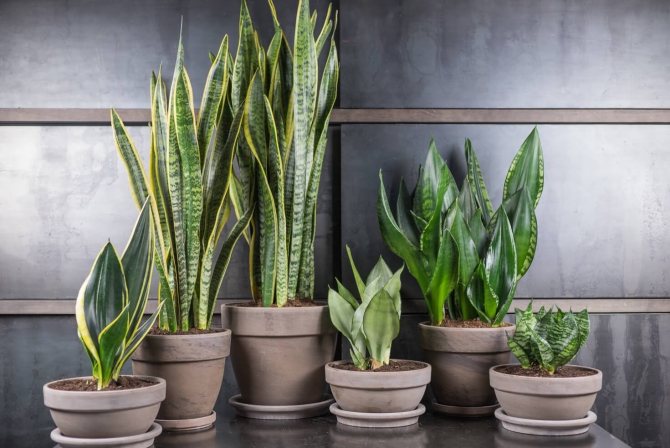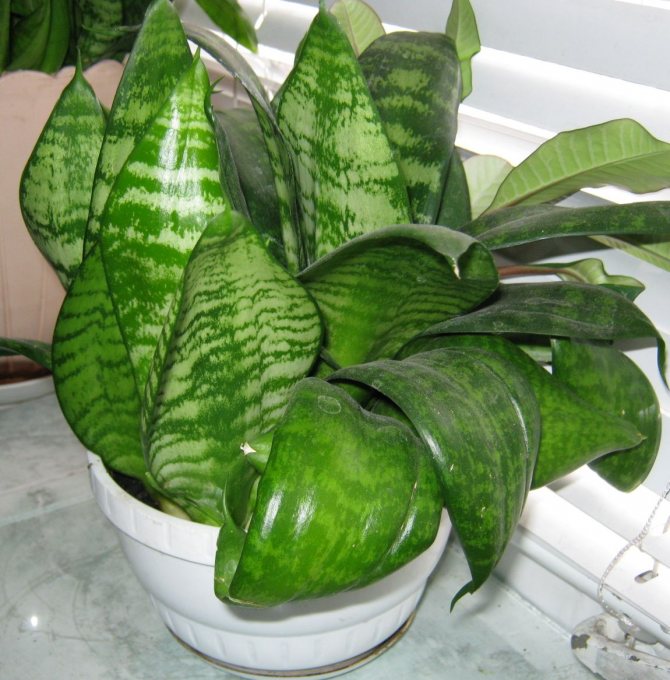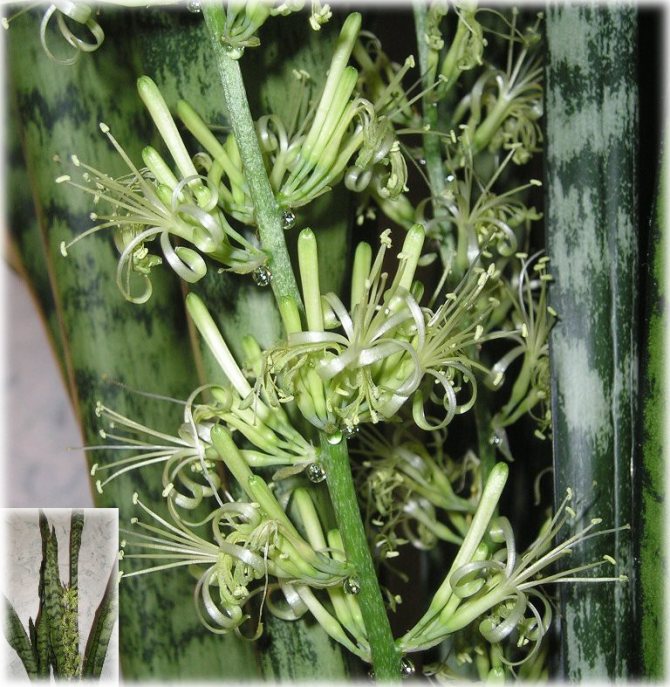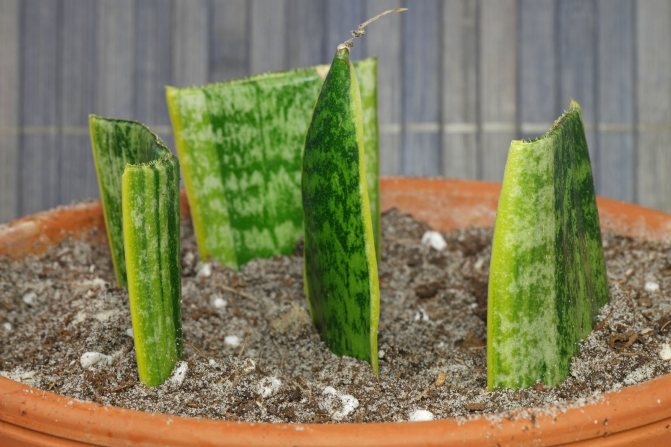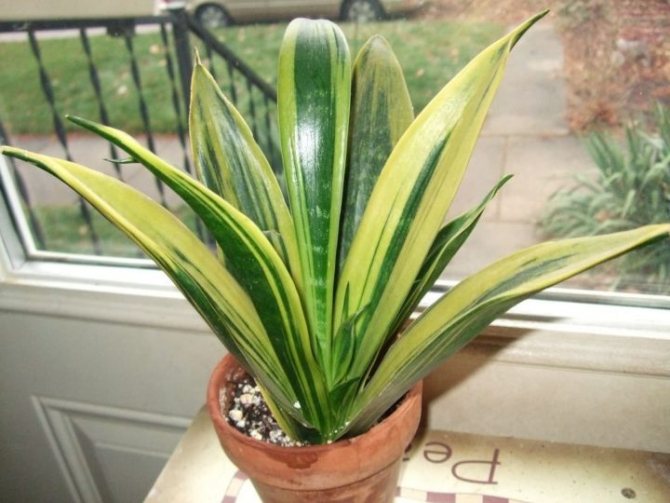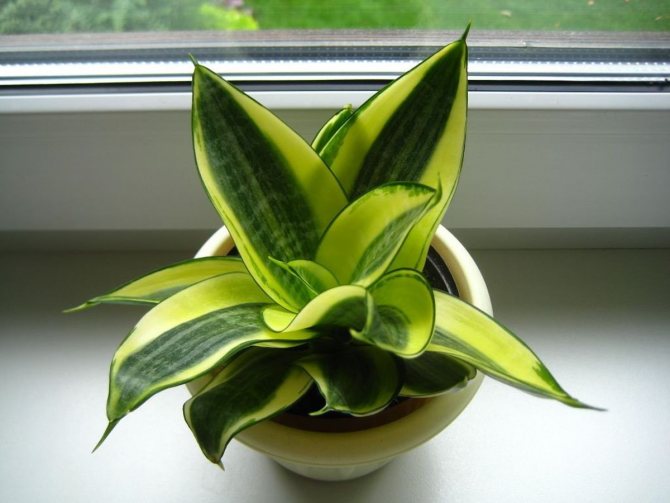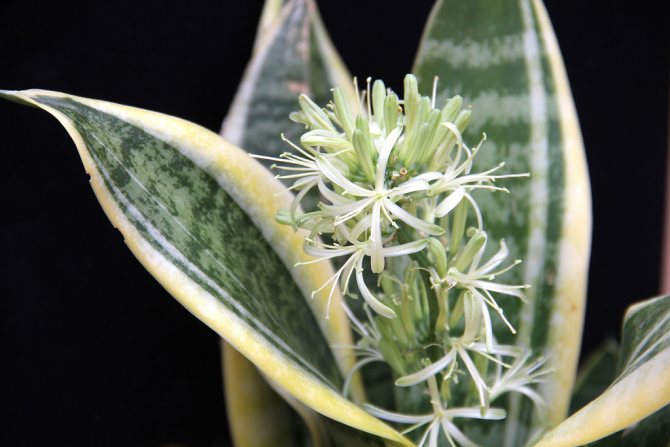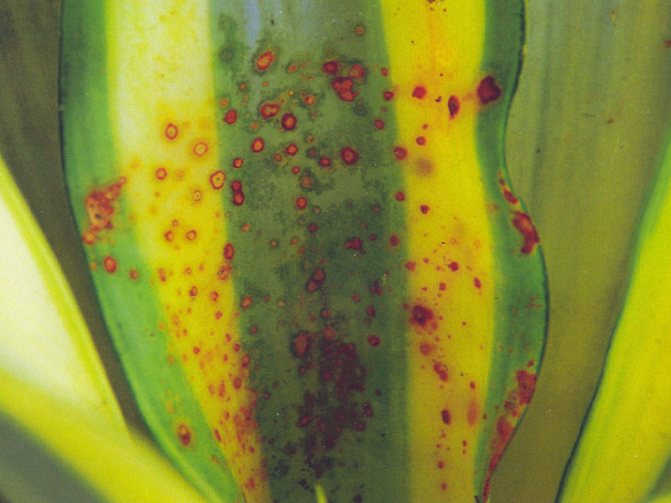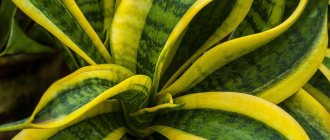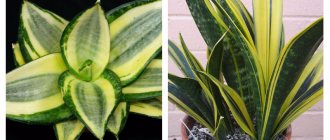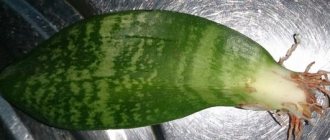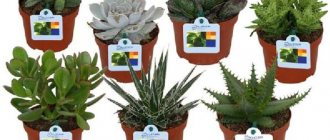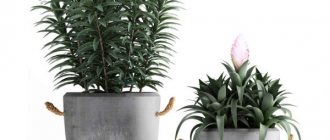- 2 January, 2019
- Houseplants
- Suzanne Nyrova
Sansevieria, "pike tail" is a plant that can withstand almost anything: dry and polluted air, high temperature and sun, frequent changes in location, lack of water (even a month without watering can cope with it). The only thing he doesn't like is the ground is too wet. Sansevieria is an interesting decorative variety of indoor flowers with long beautiful leaves. Consider what should be the care of the "pike tail" flower at home.
Origin

Sansevieria is a genus that includes about 70 species of herbaceous shrub succulents. It is a plant that originates from tropical regions of Africa - it can be found at the equator and in the southern part of the continent. It grows in the hot and humid forests of Asia. Grows well on dry and rocky soil, as well as in full sun. The flower was discovered in the mid-18th century by an Italian aristocrat from Naples, Raimondo de Sangro, Prince of San Severo, and the plant's name comes from the name of the place. Its other names, depending on the place of growth, are: flower "pike tail", "Indian sword", "wolf's tail", "mother-in-law's tongue". Also, this plant is called "devil's tongue", "leopard lily", "snake skin", "African hemp".
Diseases and pests
Mealybug
No matter how unpretentious the flower is, sometimes inattention to it can provoke diseases that will have to be treated.
- The main "scourge" of the pike tail is excess moisture... From this, the roots rot, and the flower begins to disappear. The main symptom is yellowed leaves. Treatment consists in removing the flower from the container, removing the spoiled roots and treating the remaining antifungal drugs. After that, the roots are dried for about 7 days and the mother-in-law's tongue is planted in new soil.
- Sometimes a plant can also get sick from overgrowth. Rather high "tongues" of the flower, having no support, begin to fall and then wither.
Provide inconvenience and pests - root scale insects and mealybugs... You can find out about this by pale brown or whitish spots on the leaves. You can remove insects with a cloth dipped in alcohol, and then walk with more insecticidal preparations.
Types, names and photos of the "pike tail" flower
Sansevieria are divided into two large groups:
- tall - their height reaches 2 meters, they are distinguished by lanceolate leaves;
- undersized - small plants with straight or curved leaves growing from a rosette.
The most beautiful and famous varieties are:
- Laurenti is a beautiful plant with gray-green, striped, sword-like leaves with a bright rim. The rosette consists of six or more striped leaves. Plant height can even exceed one meter.


- Hanni - is characterized by a lower stature. It has green, broad, glossy leaves with irregular dark patterns. Reaches a height of 20 cm.
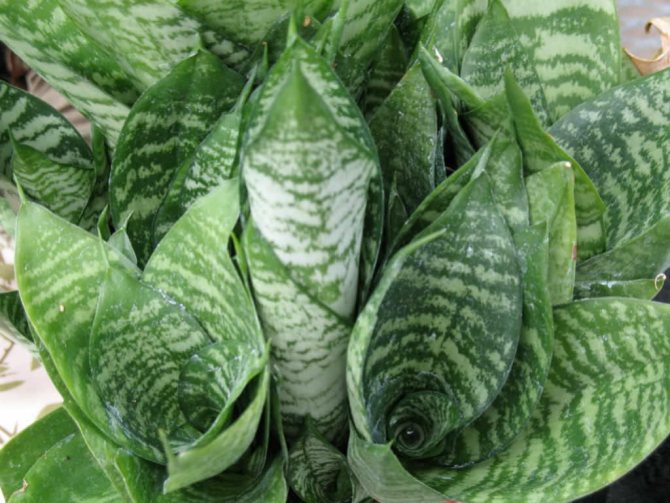

- Golden Hanni is a low plant with wide lanceolate leaves with characteristic yellow oblong spots along the edge. Reaches a height of 15 cm.
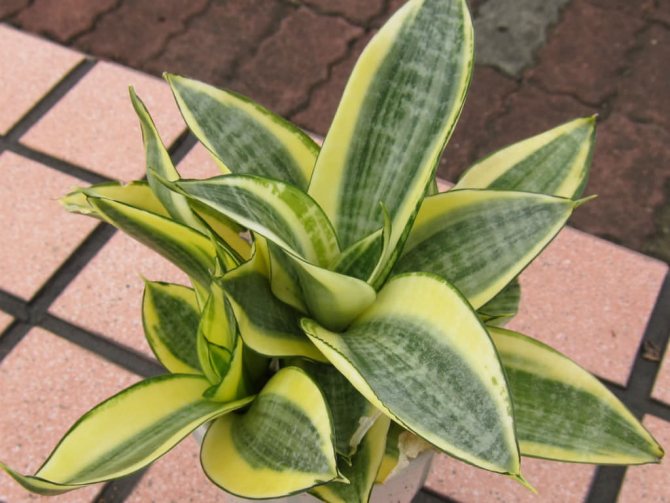

- Silver Hanni is a low plant with a silvery sheen on the leaves, distinguished by a dark edging and the presence of transverse stripes.


- Hanni Christata - with green, wide, shiny leaves. Up to 20 cm high.The second name is African hemp. It can often be seen in medical institutions, offices, as it perfectly purifies the air and eliminates odors.
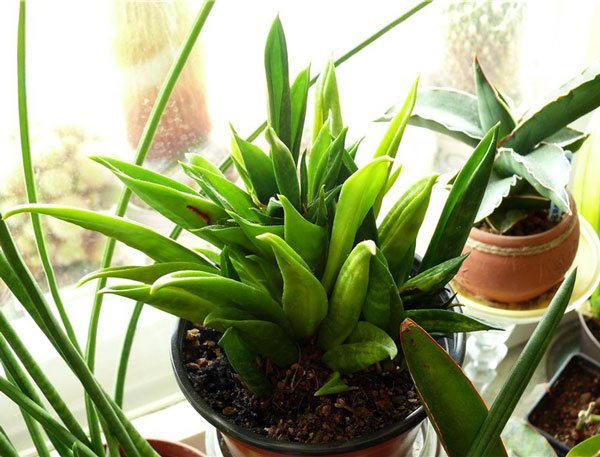

- Golden Flame is a beautiful indoor flower with yellowish green leaves. Simple enough and unpretentious to care for.
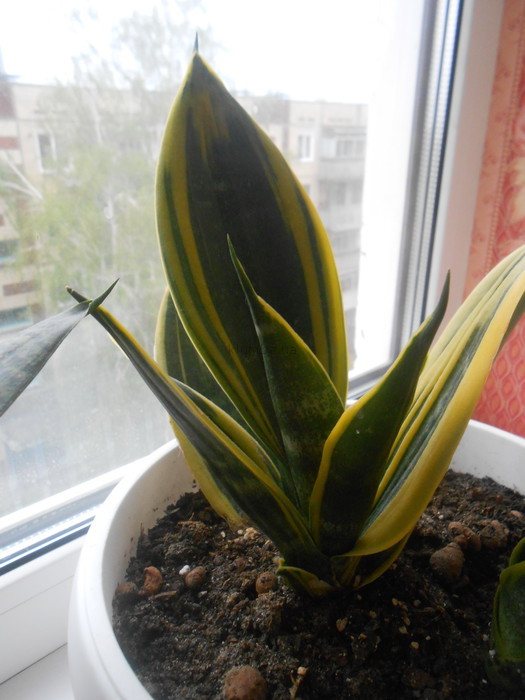

- Black Gold is a variety with dark green leaves and a yellow edge.
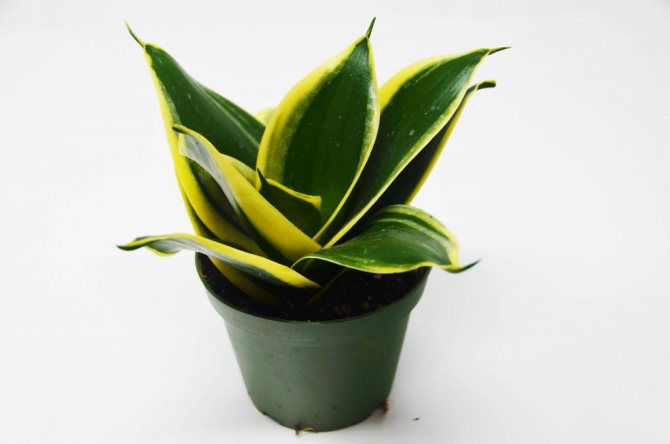

Popular varieties
The pike tail plant has such a Latin name - sansevieria trifasciata. The genus Sansevieria belongs to the Agave family. The pike tail is a frequent inhabitant of various houses and apartments. Differs in unpretentiousness and endurance. He is not afraid of drafts, irregular watering, drought. The flower can grow even in partial shade. He doesn't need frequent transplants.
Among florists, it is valued for its decorative properties. Variegated long leaves adorn any interior. It can be used to create compositions with other varieties. It has no stem, only leaf rosettes.
In the wild, the plant can be found in Indonesia, India, Africa, Madagascar. The flower has many other names: Indian sword, cuckoo tail, leopard lily.
Sansevieria is an ornamental leafy plant, but it can produce a peduncle. The inflorescences do not differ in decorativeness, and they appear extremely rarely, only if you create stressful conditions for the flower. But this does not mean that for flowering it is not supposed to follow the rules for keeping a pike tail. The difference between the inflorescences is a pleasant aroma with vanilla notes. The flowers are very small, have a whitish-greenish tint, open only in the evening, a drop of nectar appears on them. Flowering lasts a long time.


Pike tail or cylindrical sansivieria
There are 2 main types of pike tail. The first group includes those plants that have lanceolate leaves. They are erect. They can even reach a height of 150 cm. The second group includes those flowers, the foliage of which creates rosettes as it grows. These varieties are characterized by low growth. Both groups are characterized by a high density of foliage. The leaves themselves begin to form from the root.
For information
At the moment, more than 60 varieties of sansevieria are known. They differ in appearance:
- Sansevieria Laurenti... Also called the Lawrence variety. The leaves are long and narrow, their height reaches 150 cm. They have stripes of a yellow hue, which are bordered by all the leaves.
- Hanni... Another well-known variety that is very popular. Sansevieria Hanni variety is distinguished by the presence of lush leaf rosettes. They can reach a height of no more than 20 cm. Hanni has an ornament on each sheet in the form of a light strip, which is located transversely.
- Sansevieria Francis... The foliage of this variety has a rough surface. The leaves are arranged in 5 rows. The stem is very tall at first, and then it begins to creep. The height of the leaves is no more than 15 cm.
- Sansevieria prolific... Rosettes can be from 30 to 60 cm in height. They have a deep dark green tint at the base. The shape is cylindrical, the upper part is sharp.
- Sansevieria large... The rosette can reach a height of 60 cm. The leaves are ovoid. They are about 15 cm wide. The color is light green, but there are dark stripes that are located transversely and turn into a reddish border.
These are only the most popular, but there are many other types.
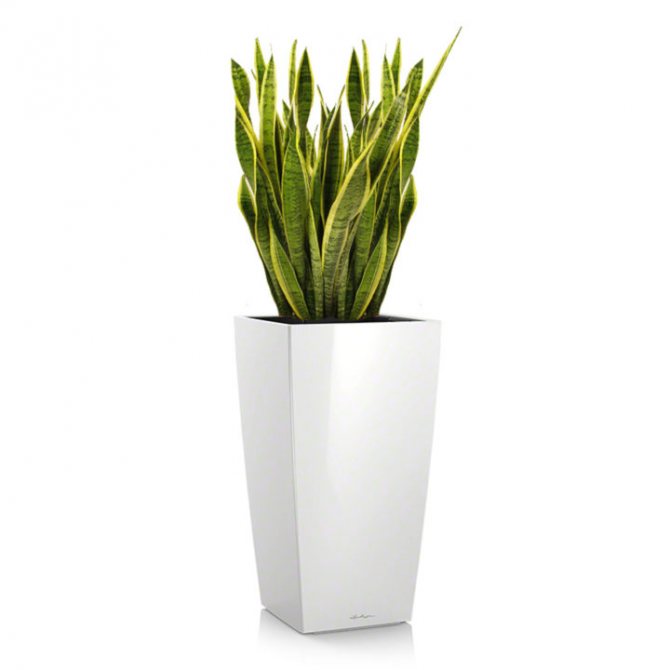

Sansivieria Laurenti
The pike tail has many beneficial properties. The flower is used against various diseases of a bacterial and viral nature. For example, it is used for inflammatory processes in the ovaries, cystitis. The plant is able to accelerate the process of tissue regeneration in case of wounds and ulcers. For otitis media, use heated fresh juice to instill the ears. In addition, the flower cleans the air from harmful components.It is able to absorb radicals that are emitted by computers, televisions and other equipment.
Appearance
The pike-tail flower is a succulent that can accumulate water in the leaves. It has a creeping rhizome from which fleshy thick leaves grow. The latter are up to 7 cm wide, and usually 40–80 cm high (some reach a length of 1.5 m). The leaves of dwarf varieties are about 15-30 cm long.
"Pike tail" - a flower with tough, raised, sharp leaves of dark green color. They are decorated with transverse, irregular stripes and patterns (brighter or darker than the color of the leaves). Some varieties have a creamy or yellow-white edge. Leaves grow directly from the soil (from the rhizome), every year 2-3 new increments appear. If the plant is properly cultivated, it should flower in late spring or early summer. It produces a long (30–90 cm) thin rod, at the end of which a branched inflorescence grows. Small, delicate, fragrant flowers are yellow-green or green-white in color. After flowering, the inflorescence should be removed to prevent fruit formation.
Flower energy and its meaning
This flower adapts to any conditions, grows well in them, without requiring strong care from the owner. According to signs, it feeds on the negative energy of its owners: it "eats" anger, resentment and anger, tunes in a benevolent mood, makes people hospitable.
To prevent the pike tail from harming with its energy, it must be placed in the right place in the house. This is considered a loggia or a room for receiving guests. The flower is ruled by the planet Mercury, the energy of which contributes to the purification of thoughts. A plant placed in the bedroom promotes restful sleep and good thoughts. It adjusts to a creative mood, makes the house more comfortable and calm. Guests and owners of the house will become more welcoming, welcoming and joyful. The flower's "antennae" - its long sharp leaves - will absorb all negative energy, it will process it and fill the house with positive.
Signs say that with the help of a pike tail, you can get rid of ill-wishers.
To do this, the plant can be put in your workplace, and it will help you focus on work, achieve success and realize creative ideas.
The pike tail feeds on energy, while it rarely gets sick. It helps to tune in to a creative, constructive mood, learn to understand each other, cherish loved ones, forget grievances and quarrels. The energy of the space in which sansevieria lives will become more positive, noble and calm.
To get rid of noise, deceitful people, from everything that prevents you from concentrating on your creativity and your own goals, it is the pike tail placed in the work area that will help, according to old signs.
Benefit


The pike-tail flower, in addition to its decorative qualities, has a number of beneficial properties for health:
- cleans the air and removes odors;
- the plant extract is used in medicine as an anti-inflammatory, choleretic and laxative;
- cut leaves of the plant, like aloe, are used to heal wounds;
- a decoction of the flower is used for infections of the genitourinary system;
- the juice of the plant helps with otitis media.
Interestingly, no matter how much research scientists have done, they have not been able to find a single property of a flower that is harmful to humans or animals. On the contrary, the plant is so beneficial that it is often found not only in apartments, but also in schools, hospitals and other public places.
Beneficial features
Perennial succulent is used in folk and traditional medicine. Along with aloe juice, they are successfully treated with sansevieria juice, as well as a decoction of the root and even the smell of a flower. The ways of using Sansevier at home and in distant countries differ little. External and internal use plants are justified for diseases such as:
- colds: drops of juice diluted with water help with a runny nose and ear pain, expectorant;
- for the treatment of skin problems: burns, wounds, dermatitis, scabies, ulcerative inflammation;
- gynecology: inflammation of the appendages, cystitis;
- intestines: laxative effect;
- hypertension and headache:
- stabilizes blood pressure and relieves headache the smell of dry leaves.
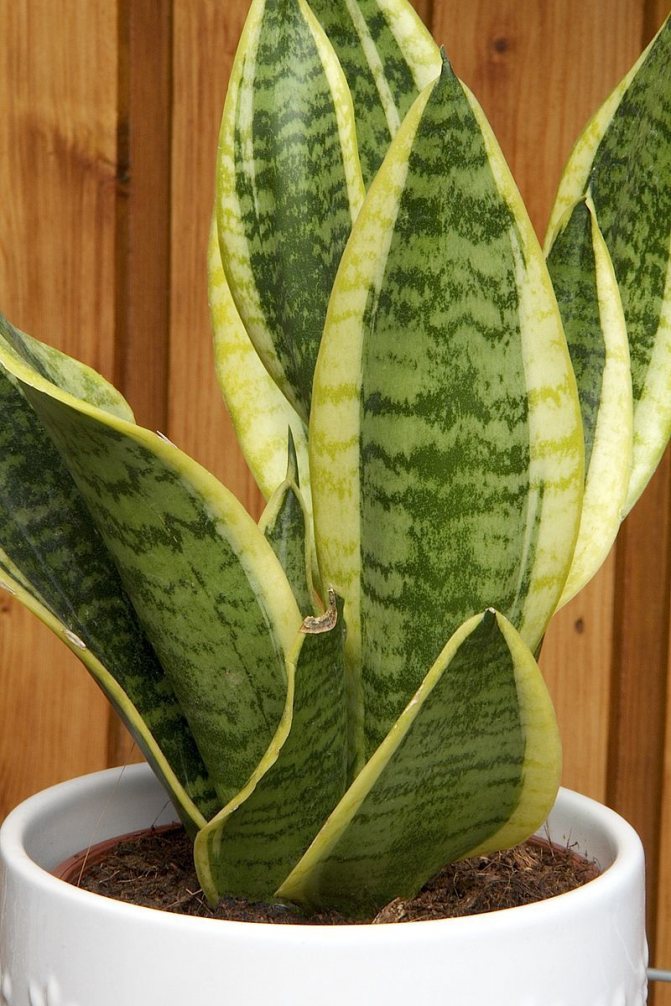

Sansevier should be used for medicinal purposes carefully and only after consulting a doctor.
The plant is also used in cosmetology. "Pike tail" contains glycosides that are readily soluble in water and alcohol. Saponin is present in organic acids, which means soap in Latin. It is found in cosmetics and detergents.
Despite the fact that the homeland of Sansevier room is hot countries, the flower has taken root perfectly on the windowsills of Europe and northern continents. A spectacular unpretentious evergreen plant can be grown at home and in office premises. Sansevier is not only a decoration of the room, but also fills it with positive energy.
Pot substrate
The pike-tail indoor flower should be planted in a rough environment, it can even be rocky. Experts most often recommend a cactus substrate, although equally good growing results are seen in a mixture of universal potting soil (pH 7.5), compost, sand or perlite. Peat use should be kept to a minimum. The drainage layer should be placed on the bottom of the pot, which will allow excess water to drain freely.
For a plant, you can use the following soil mixture:
- turf - 2 parts;
- leafy soil - 1 part;
- humus - 1 part;
- peat - 1 part;
- sandy soil - 1 part.
Mix all components and lay on a drainage layer.
The history of the flower, its homeland
The pike tail comes from Of Africa... It also grows naturally in Asia. The usual conditions for him are semi-desert and desert. In the 18th century, the plant was found by Petanga, a naturalist from Of Italy, and brought to Europe.
For 2 centuries, more than 60 species of pike tail have been bred. The most popular varieties appeared in 1939: Compacta, Silver Hahnii, Goldiana, etc. They were bred by Louisiana W. Smith.
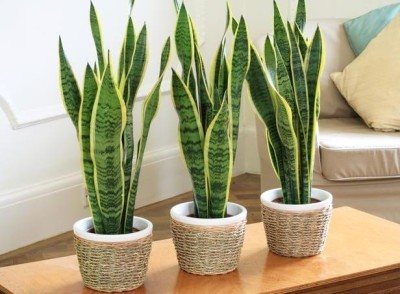

The natives made bowstrings from African hemp leaves. In Africa and Asia from sansevieria make ropes, sea ropes, weave baskets, use it to create hedges.
Plant sap - antiseptic. In folk medicine, it is used to treat cystitis, inflammation of the appendages, as a means of stimulating the immune system.
Watering
The pike-tail house flower is very drought tolerant. The plant can survive for up to four weeks without watering. For him, excessive watering is much more dangerous, as a result of which the rhizome and leaves begin to rot (the plant cannot be saved in this case). Sansevieria should be "watered" in the summer once a week or once every two weeks; in winter, watering is limited in accordance with the principle: the colder, the less water. Sometimes it is enough to water it every three to four weeks (only when the soil in the pot is clearly dry).
For irrigation, you can use ordinary tap water, because sansevieria loves calcium, and an excess of this element does not harm it. Water for irrigation should be at room temperature. Water is best poured into a pot holder and excess water removed to prevent root and leaf rot.
Sansevieria does not tolerate spraying with water. Dust from the leaves should be regularly wiped with a damp cloth, which will improve the appearance of the plant and ensure more efficient photosynthesis. Formulations used to make indoor plants glossy can cause brown or rusty spots on the leaves.
Can the plant be kept at home?
Despite a number of negative superstitions, pike tail is useful to keep in the house.
- This plant is able to filter negative emotions and protect household members from envious people and ill-wishers.
- By the appearance and condition of the flower, you can determine the quality of family relationships, and in time to recognize the signals for future troubles.
- Due to a number of features, the pike tail is a medicinal plant capable of disinfecting and healing wounds. A plant that has medicinal properties cannot cause serious harm to its owner.


Keeping a pike tail in the house is better for energetic and business people, public figures and those who feel wounded. With a careful attitude and the right location, the plant can have a positive effect on family members.
The pike tail is a family plant that has a positive effect on young or established couples, as a result of which, unmarried girls should be especially careful when handling the plant.
REFERENCE: For young girls just awaiting cohabitation or marriage, sansevieria can help in choosing a partner. To do this, you need to guess the name of the chosen one on one leaf of the plant and wait 30 days. If nothing happens to the leaf, then in reality a strong bond can arise with this man. Otherwise, the union is doomed to failure.
Transfer


Young sansevierias should be replanted every two years, older ones every three years. The new flower pot should be a few centimeters larger in diameter than the old one. A layer of drainage 2-3 cm thick is laid on the bottom of the pot (this can be gravel or broken remains of a clay pot). The container must be heavy and sturdy. A clay pot that is relatively wide is ideal, because in light and narrow plastic containers, a plant with heavy and tall leaves can easily fall off, especially in winter when the soil is very dry. Pots should also have fairly thick walls, because the roots of the flower grow quickly and intensively, and the fragile container can simply crack under their pressure.
Lighting for growing sansevieria
The plant is capable of being in partial shade for a long time. It is desirable to provide the flower with uniform sunlight. The brightness of the leaves and the full development of the culture depends on the length of daylight hours. If the flowerpot is located on the windowsill on the south side of the building, it is necessary to protect the sansevieria from direct sunlight.
Variegated varieties with a prevailing yellow tint are less demanding on the illumination of the site than the classic green representatives of the culture. For successful cultivation, place the potted plant next to a window. Colored areas are particularly susceptible to sunlight. Therefore, it is necessary to shade windows in a timely manner using blinds or roller shutters.
Reproduction
The plant can be propagated by cuttings or by separating the rhizomes. Seedlings are picked in the spring (March - early April); two-year-old leaves are best suited for this. Cut the leaf at the base and cut it into small pieces (about 5-6 cm). The lower part of the seedlings should be immersed in Kornevin for a while, and then placed in a container filled with a mixture of sand and peat (in a 1: 1 ratio). For a month and a half, the seedlings should be placed in a bright room at a temperature of about +20 ° C, and then transplanted into separate pots.
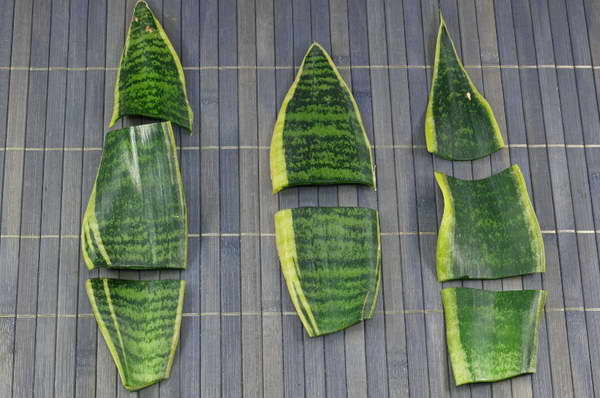

Newly grown flowers do not replicate the characteristics of the parent plant - no matter which variety was used for propagation, the leaves of the new plant will always be dark green.
If you want to propagate a flower by dividing its rhizome, it is best to do this in late summer (September). The plant is carefully removed from the pot and divided into 2-3 parts.Each part should be treated with a fungicide to prevent dangerous diseases. It is necessary to wait a few days for the wounds on the plants to heal and then transplant into separate containers. Propagating sansevieria by dividing the rhizome ensures that the new plants are exactly the same as the mother plant.
Root layers
This is the easiest way to get yourself such an unpretentious flower as a pike tail. The homeland of the plant is rather harsh with regard to climatic conditions, therefore, sansevieria, striving to occupy new habitats, forms a rather dense root growth. This behavior is characteristic not only of those growing in the wild, but also of domesticated flowers. Usually, a lot of shoots with roots are formed in a pot.
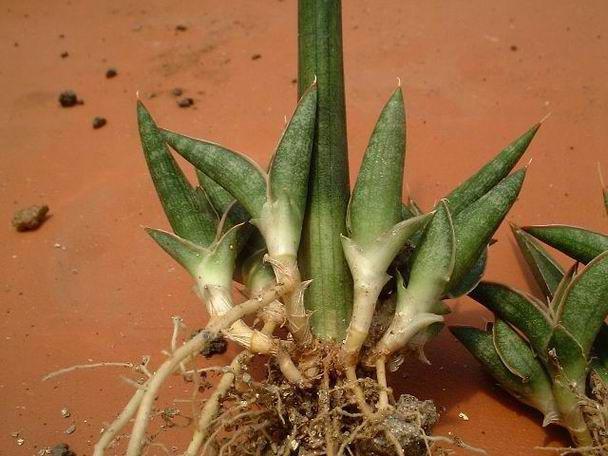

Dig out a few (along with roots and earthy clod) and cut from the mother plant, then transplant into a new pot. The place from which you cut a piece must be dried a little and sprinkled with crushed coal, you can use the usual activated one.
Growing problems
The plant is most often affected by the following pests:
- Spider mite - negatively affects the leaves, after which they become pale and begin to dry out. Indoor flowers in this case should be sprayed with an insecticide, often wipe their leaves with a damp cloth.
- Thrips - create whole colonies on the leaves of a plant, especially on their back. The affected parts are characterized by a gray-brown color. The flower should be treated with insecticide and other pest chemicals.
- Mealyworms - appear closer to the base of the plant, and feed on the sap of the leaves. The affected part bends unnaturally, turns yellow and dies. Powdery mildew can be removed from the flower by hand, then wipe all parts of the plant with a damp cloth and spray with karbofos.
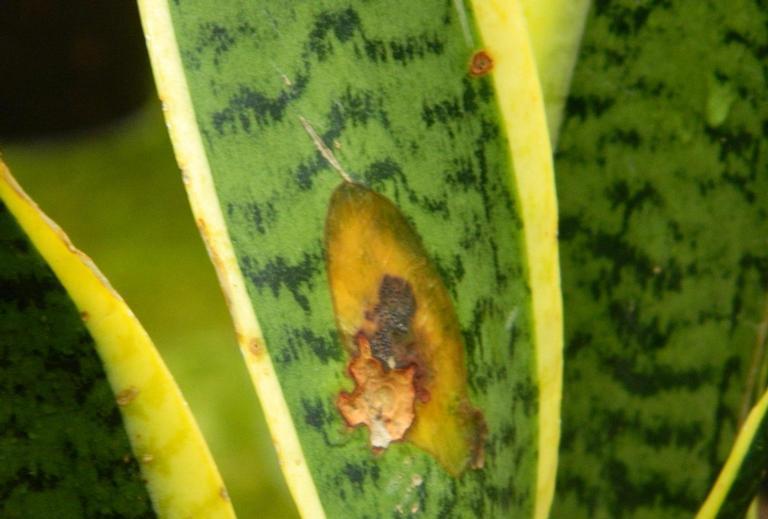

In addition to pests, the plant can attack diseases due to improper care of it.
- With excessive fertilization of the flower, young leaves become lethargic, weak and soft - then you should stop feeding for some time.
- If the plant is watered too abundantly, brown spots and rot may develop on the leaves. The amount of water used to water the plant should be reduced, and diseased leaves should be cut right next to the rhizome and discarded.
- Leaves of plants that stand on the windowsill can be burned by strong sunlight (especially in summer). If there are signs of a burn on the flower, cut out the damaged parts at the base and move the pot to partial shade.
- Too bad lighting causes weaker coloration of the leaves and the disappearance of the decorative stripes and patterns of the plant.
If you like the pike-tail flower, home care will not take much of your time. But sansevieria will be an excellent decoration for your home.
Flowering features
Spathiphyllum flower - reproduction at home
Growing this houseplant at home, novice gardeners do not immediately realize that it can bloom. Oddly enough, pike tail bloom is a defensive reaction to unfavorable conditions, for example, lack of water, low temperatures or lack of fertilizer.
In the process of flowering, sansevieria produces a long stem with small white flowers. To speed up this stage, it is enough to leave the plant without watering for 1-2 months. Such measures stimulate its defensive reaction, as a result of which it continues its race.


Sansevier leaves
The use of sansevieria
At home, sansevier is successfully used as a hedge. Its leaves contain valuable technical fiber, from which the locals used to make bowstrings. Currently, in tropical countries, certain types of sansevier are cultivated for the production of this fiber.Sansevieria is also a medicinal plant. It is used to treat cystitis, inflammation of the appendages. With the help of this plant, you can increase resistance to viral and colds, enhance adaptive abilities.


Sansevieria has been grown in Europe as an ornamental plant since the 18th century, being considered an unpretentious and hardy plant in indoor culture, which is suitable even for a novice grower. In summer, sansevieria adorns artificial landscapes, as its spectacular leaves provide a wonderful backdrop for plants with small flowers or feathery leaves. This plant is used for landscaping winter gardens, creating compositional arrangements.
Folk omens and superstitions about the flower "mother-in-law's language"
The Russians jokingly called him "mother-in-law" for the long and sharp leaves. Associated with him many positive signs... Here are just a few of them:
- bloomed in summer - everything will be fine in life, good news will come, a child will be born;
- dense leaves of the same size - a light aura “lives” in the house;
- inherited sansa prevent quarrels between spouses, drive away envy and save material well-being.
Negative beliefs are also known among the people:
- life will be unsuccessful for an unmarried woman;
- if a widow or a single woman presented it to the newlyweds - expect quarrels and all kinds of everyday problems;
- the leaf dries from the upper edge - envy walks nearby;
- leopard lily turned yellow - separation from a dear person is close;
- threw out peduncles in winter - major family discord or troubles in the work collective;
- the leopard flower died - someone from the household suffers a lot, or a misfortune has settled in the dwelling, which nature can no longer neutralize.
How to avoid negative signs?
There are rules on how to get around superstition:
- do not place by the bed, especially the nursery;
- do not accept as a gift from single people and relatives, especially for a birthday, anniversary.
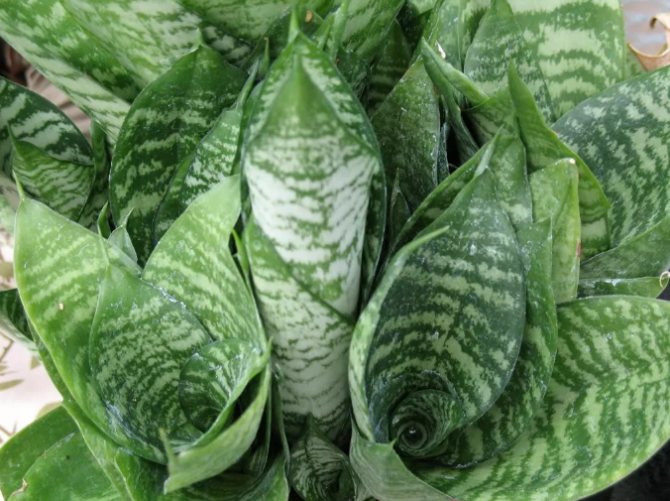

Sansevieria is very sensitive to good grooming. The flower is sensitive to both the care of the owner and the hostile attitude. Whether he is needed in the house - a person decides on his own. It is important to know some rules, then this "green warrior" will become your irreplaceable assistant.


